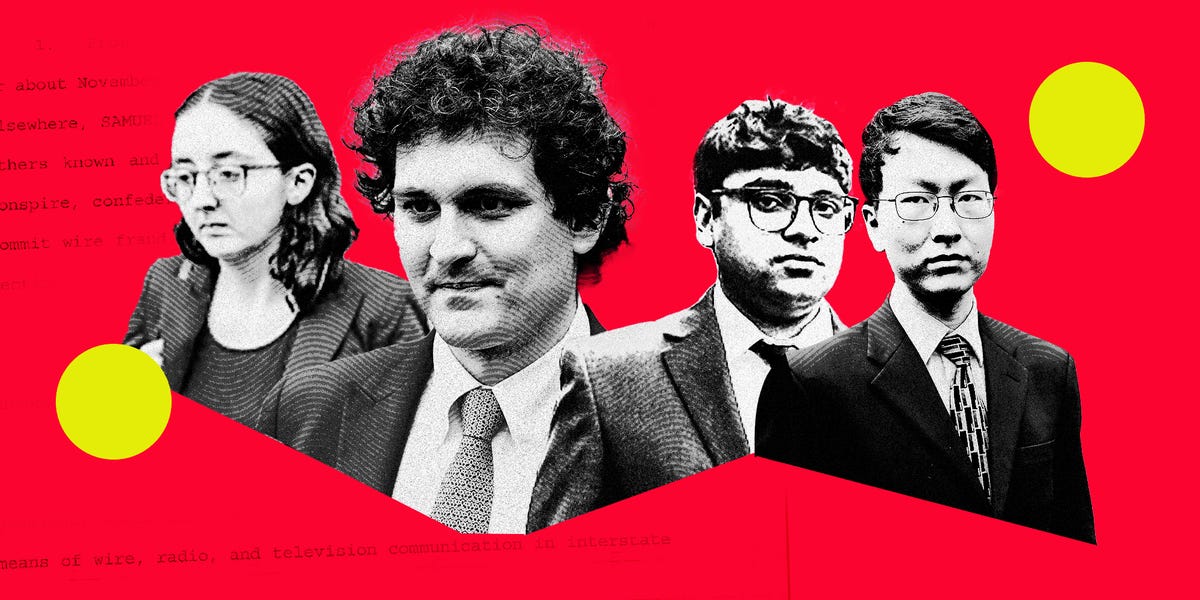- Prosecutors say Sam Bankman-Fried lied under oath on the witness stand.
- In closing arguments, they say he shaped his testimony around what other witnesses said during the trial.
- If a judge agrees, Bankman-Fried could get a harsher sentence.
In closing arguments for Sam Bankman-Fried’s criminal trial Wednesday, prosecutors say the disgraced cryptocurrency mogul repeatedly lied on the witness stand.
Bankman-Fried made the unusual decision to testify in his own criminal case, potentially risking a greater prison sentence if he’s found guilty and the judge agrees with prosecutors that he lied under oath.
Assistant US Attorney Nicholas Roos, one of the prosecutors in the case, noted in the morning’s closing argument that Bankman-Fried was more forthcoming with his answers under questioning from his own attorney — but was far more halting and equivocal when prosecutors grilled him on the stand.
“Did you notice his testimony on Friday was smooth, like he rehearsed a lot?” Roos told jurors in a downtown Manhattan courtroom.
Bankman-Fried, questioned by his attorney Mark Cohen, talked about “a lot of stuff that didn’t matter in this case,” like the configuration of his student living space at MIT, the office layout at Alameda Research, and why he chose to have FTX spend more than $100 million to sponsor the arena for the Miami Heat instead of another sports team.
But asked questions by his colleague Assistant US Attorney Danielle Sassoon, Bankman-Fried said he “couldn’t recall” the answers to questions more than 140 different times.
“He lied about big things and about little things,” Roos said. “He approached every question like up was down and down was up.”
Prosecutors allege Bankman-Fried defrauded millions of FTX customers by stealing their deposits and using them for Alameda. He used the money, prosecutors say, for personal investments, to repay loans, in extravagant advertising, to buy properties around the world, and for political donations.
The “pyramid of deceit,” as Roos described it, collapsed in November of 2022 when customers tried to withdraw their money en masse, revealing that FTX didn’t have the cash on hand to fulfill the withdrawals.
In his own version of events, Bankman-Fried claimed that the vast majority of FTX customers opted into the exchange’s risky spot-margin trading system, which meant their accounts could be drained in certain rare conditions. The crypto market downturn in November 2022, he says, meant Alameda suffered enormous losses and, as a customer on the FTX exchange, led to other users’ accounts losing money to fill that hole.
On Wednesday, Roos refuted that story.
“This is not about complicated issues like cryptocurrency, about hedging, about investing,” he said. “It’s about deception, it’s about lies, it’s about stealing, it’s about greed.”
Alameda’s account on FTX, Roos pointed out, did not even have the spot-margin trading option enabled. It simply had a secret $65 billion line of credit, and also for a time secretly owned the bank account where customers wired their deposits onto the FTX exchange.
“Once FTX deposits landed in Alameda bank accounts, they were treated like free cash,” Roos said.
In the trial, prosecutors presented testimony from three members of Bankman-Fried’s inner circle who had been longtime friends and served as executives at FTX, Alameda, or both.
Those former executives — Caroline Ellison, Gary Wang, and Nashad Singh — all pleaded guilty to co-conspiring with Bankman-Fried to defraud customers. (A fourth executive who pleaded guilty to the conspiracy, Ryan Salame, didn’t have a cooperation agreement that required him to testify.)
All of them said they knew they were doing something wrong when they understood they were using customer funds. Roos also noted that other employees who testified, like developer Adam Yedidia and FTX lawyer Can Sun, resigned as soon as they understood the company had raided customers’ coffers.
Roos said that Bankman-Fried, after listening to their testimony in court, shaped his own testimony to tell a story that conveniently left him out of the loop during key moments.
“You would have to ignore the testimony of his partners in crime,” Roos said.
Roos noted one moment in Bankman-Fried’s testimony where FTX employees discovered a bug that wrongly stated Alameda’s liabilities on the exchange.
It turned out that Alameda owed $8 billion to FTX, not $16 billion as previously believed. While Bankman-Fried said he canceled a trip to Washington, DC, to testify before Congress so that he could stay in the office and handle the issue, he claimed on the witness stand that he didn’t remember learning about the $8 billion hole at the time.
That explanation, Roos said, was “simply not credible.”
“The truth is there is just one person who had the motive to set up the secret system for Alameda to borrow unlimited amounts of FTX customer money,” Roos said.
Bankman-Fried’s attorney is scheduled to deliver his closing argument Wednesday afternoon.
Read the full article here





